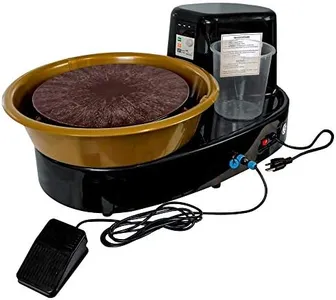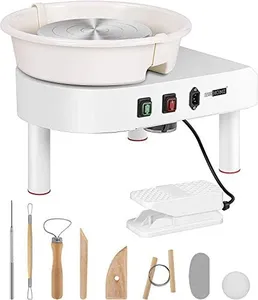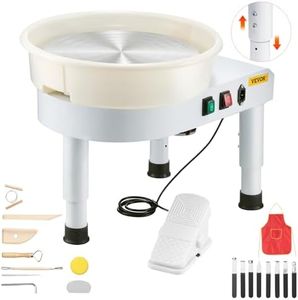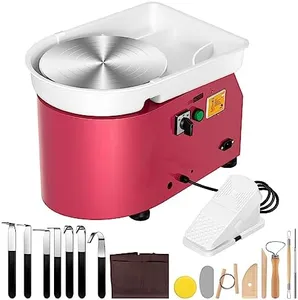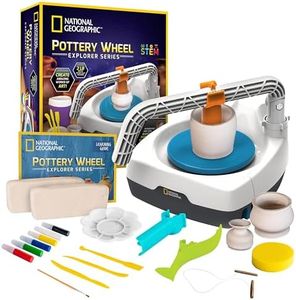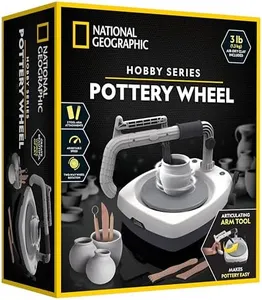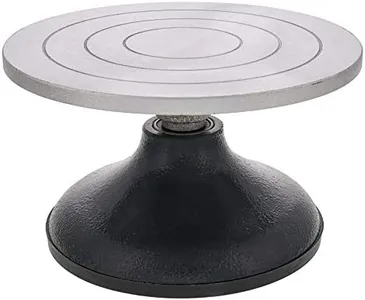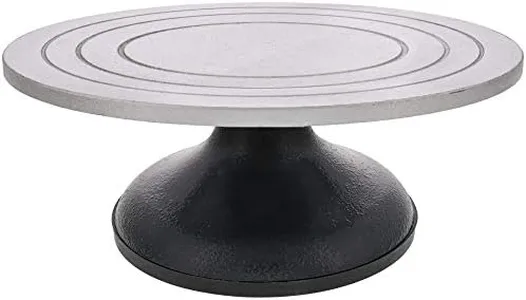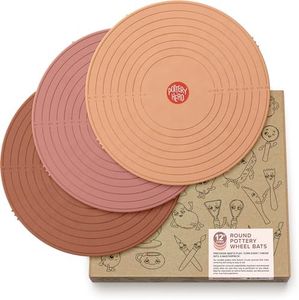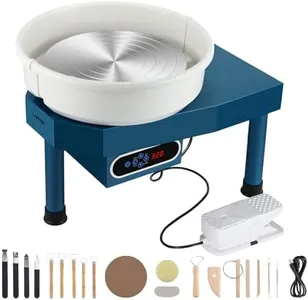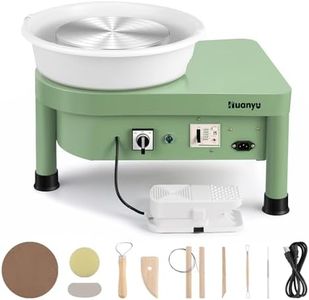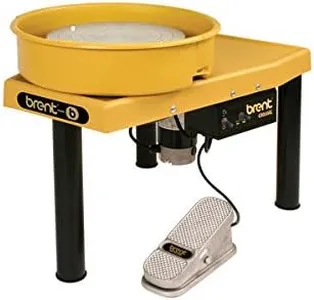10 Best Pottery Wheels 2025 in the United States
Our technology thoroughly searches through the online shopping world, reviewing hundreds of sites. We then process and analyze this information, updating in real-time to bring you the latest top-rated products. This way, you always get the best and most current options available.

Our Top Picks
Winner
VIVOHOME 25CM Pottery Wheel Forming Machine 350W Electric DIY Clay Tool with Foot Pedal and Detachable Basin for Ceramic Work Art Craft White
Most important from
579 reviews
The VIVOHOME 25CM Pottery Wheel is a well-rounded machine designed for both beginners and more experienced ceramic enthusiasts. With a sturdy steel body and a 9.8-inch aluminum alloy wheel head, it is built to last and resist corrosion and rust. The wheel operates at speeds up to 300 rpm with a motor power of 350W, providing sufficient torque for most clay projects. The inclusion of a foot pedal allows for hands-free speed control, a feature that adds to its usability, especially during intricate tasks.
One of its standout features is the ultra-low noise level, below 60 dB, making it ideal for use in quieter environments like homes and classrooms. Additionally, it offers safety features like grounded leakage protection and CE certification, ensuring peace of mind during operation. However, this machine lacks reversibility, which might be a drawback for some users looking for more versatile wheel rotation options.
Weighing around 25.7 pounds and with dimensions of 19.7 x 15.7 x 10.2 inches, it is relatively portable and can easily fit into small workspaces. For its price point, it is a competitive choice, especially given its robust features. However, professional potters looking for advanced features might find it somewhat basic.
Most important from
579 reviews
VEVOR 14in/35cm Pottery Wheel for Adults, 0-2in Lift-Table 450W Professional Pottery Kit with Foot Pedal Detachable Basin DIY Art Clay Potter's Wheel for Kids Adults Beginners at Home Pottery, White
Most important from
294 reviews
The VEVOR 14in/35cm Pottery Wheel is designed for adults and beginners with a number of thoughtful features. The 450W brushless motor promises strong performance, capable of handling up to 18 lbs of clay, which is suitable for most home pottery projects. The 14-inch aluminum alloy turntable is substantial enough for various pottery sizes. The adjustable speed between 60-300 rpm, controlled via an independent foot pedal, allows precise control over your work, which is a significant advantage for both beginners and experienced potters.
Additionally, the wheel's forward and reverse capabilities offer flexibility in shaping your creations. Portability is enhanced with a detachable ABS water basin that makes cleaning easier, though the machine itself might be on the heavier side due to its robust build. The lift-top design provides ergonomic flexibility, accommodating users of different heights, and the triangular structure ensures stability during operation. Noise levels are generally low due to the brushless motor, making it conducive for home use.
It includes safety features like earth leakage protection and reinforced pads, making it a secure choice. The comprehensive accessory kit and waterproof apron add value, making it a great gift for pottery enthusiasts. This pottery wheel is ideal for beginners, hobbyists, and even professional ceramic craftsmen looking for a reliable, user-friendly machine for home use.
Most important from
294 reviews
VIVOHOME 28CM 11Inch Large Electric Pottery Wheel Forming Machine Ceramic Clay Wheel with Foot Pedal Detachable Basin DIY Tools for Adults Beginners Pink
Most important from
579 reviews
The VIVOHOME Electric Pottery Wheel is well-suited for both beginners and experienced potters, thanks to its user-friendly design and practical features. One of its notable strengths is the motor power, which allows for adjustable speeds ranging from 0 to 300 RPM through an easy-to-use foot pedal. This hands-free operation provides flexibility during crafting, enhancing the pottery-making experience.
The wheel's size is another positive aspect; with an 11-inch diameter, it offers enough space for various pottery projects while maintaining a compact footprint. The detachable basin is a real convenience, making cleanup simple after your creative sessions. In terms of safety, the VIVOHOME wheel comes equipped with features like an earth leakage protection device and an air switch to prevent short circuits, which is reassuring for users concerned about electrical hazards.
There are a few drawbacks to consider. While the noise level is kept under 60 dB, which is relatively quiet, some users may find it noticeable during prolonged use. Additionally, at 27.2 pounds, the wheel may be challenging to move around for those looking for a more portable option. The included accessories further enhance this pottery wheel's appeal, as they cater to various shaping and modeling needs. However, the machine's performance is primarily designed for throwing and shaping, which may not meet the needs of advanced pottery techniques.
Most important from
579 reviews
Buying Guide for the Best Pottery Wheels
Choosing the right pottery wheel can significantly impact your pottery experience, whether you're a beginner or a seasoned potter. The right wheel will help you create your pieces more efficiently and comfortably. When selecting a pottery wheel, consider the following key specifications to ensure you find the best fit for your needs.FAQ
Most Popular Categories Right Now
